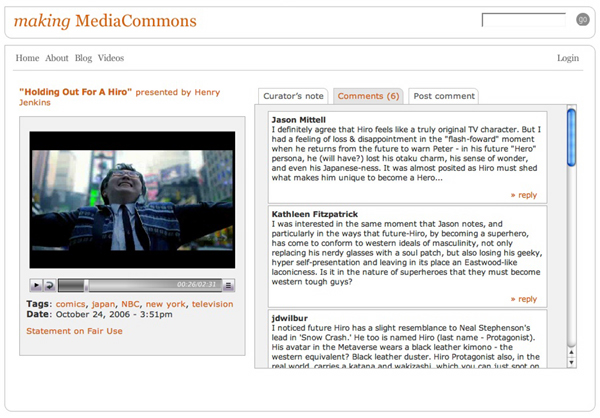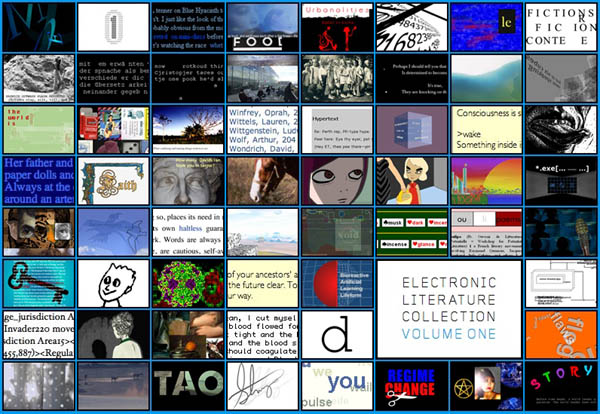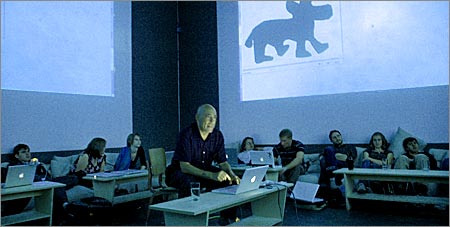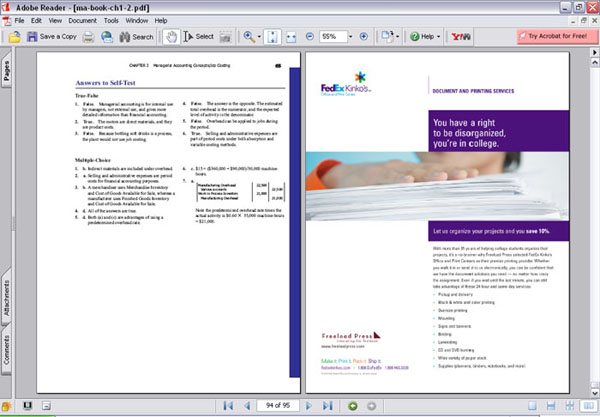Ed note: John McClymer of Assumption College, MA is a teacher and scholar of American History, who attended our nexttext history meeting last spring.
The string of adjectives in my title comes from Kathleen Fitzpatrick’s fascinating “Introducing MediaCommons” of July 17, 2006. Fitzpatrick uses them to describe the “new scholarship” MediaCommons can help promote. They apply with equal force to the teaching this new environment can foster, as Avi Santo’s post on revised pedagogies demonstrates. He sets forth the goals we need to pursue. My task is to explore a specific set of pedagogies suited to teaching history.
Ever since I attended my first workshop on the internet, I have been groping towards such a pedagogy. I think that I am now coming within hailing distance. So I extend an invitation to peers to take a look at what I will be seeking to do in an upper-level course on the history of the Gilded Age and Progressive Era this fall.
First I need to say a few words about history as a field of study. It is what some cognitive psychologists call “ill-structured.” Chemistry, for example, is well-structured. There is nothing equivalent to the Periodic Table in history. There are no formulae, no model problems. Nothing is reproducible. The historian never can isolate a particular phenomenon. We can never measure anything precisely. The evidence we need to make sense of comes in a wide array of forms, ranging from sermons to furniture, from battle plans to cartoons. No matter what the topic, furthermore, we know there are crucial missing pieces. Some we can someday discover. The rest is simply lost forever. As a result, say the cognitive specialists, history as a discipline requires a very high degree of intellectual flexibility.
Because it does, it is especially ill-served by what we can call pedagogies of scarcity. Consider the standard U.S. survey textbook. Despite its bulk, its authors have had to make innumerable painful choices about what to leave out. There is exciting new scholarship about, let us say, women in the antebellum South. If that is going to be included in a new edition, something of equal length must come out because the overall size of the text is fixed. So is the number of illustrations. Authors and editors must choose one painting to represent the Ash Can School. They must select one way of explaining the abolition movement. They must pretend, in short, that history is a well-structured field.
This necessarily carries over to the tasks we assign students to undertake. “Discuss the rise of imperialism in late nineteenth-century America” we ask. What is wrong with such a question? It is bogus. Students CAN solve for x; they CAN prove that two geometrical figures are congruent. They CANNOT “discuss” the rise of imperialism. They can only demonstrate that they know the version of the story found in their textbook or that they transcribed in their notes. Scarcity routinely leads historians to ask inauthentic questions. One proof is that we ask students to write an in-class essay on the rise of imperialism but caution the same student that the topic, as phrased, is too broad for a term paper.
History as a discipline does not admit of closure. We can prove theorems. We cannot state definitively the significance of race in American history. Yet we routinely pretend that we “cover” topics in our lectures. And we make students pretend that they understand topics whose mysteries continue to perplex us. All the adjectives in my title are antonyms for such inauthentic learning.
The course site contains a discussion of what authentic means in history, so I will not rehearse that here. Instead I will discuss why I approach the course in the ways I do. I will also highlight questions that continue to bedevil me as I continue to work on this course.
Creating a Community of Learners In and Outside the Classroom
My course builds upon work done over a number of semesters in an American Studies course at the University of Virginia that uses an online version of Alan Trachtenberg’s classic The Incorporation of America: Culture and Society in the Gilded Age. Over several semesters students in that course have created web sites that explore Trachtenberg’s ideas. My students and I, therefore, will be joining an existing scholarly community, albeit unbeknownst to the large majority of its members whose work of semesters past we will use. Their work provides us with models as well as information and ideas. Our work, we hope, will do as much for other classes on other campuses.
We will work as a community in class as well. All of us will read Trachtenberg’s chapters and hold a preliminary discussion for each. Then participants will pick among an array of resources relevant to a particular chapter. They will report their findings, first to me an hour before class via email. Then they will report them to each other. I insert myself here in the process for several reasons. One is quality control. I have no desire to encourage class discussion for its own sake. The format I’ve adopted guarantees that students will do the great majority of the talking. What I need to insure is that the most interesting ideas get a full and fair hearing. As a result, I need to know in advance who has what to say.
I take the best posts and create a web page. I do not hesitate to edit student notes, usually by deleting extraneous material. It is not uncommon for a student post running a page or more in length to show up on the course page as a paragraph or sometimes a sentence. All of this provides immediate feedback to the students. Some of it is negative, at least by implication. But the overall message is positive. Whenever I ask a student to contribute it is because I know that she has something worthwhile to add to the discussion. This means that students can relax.
Providing Multiple Points of Entry
Because they choose the materials they will work on, students can play to their strengths and their interests. This is, in fact, how practicing historians choose their own projects. Sometimes students rue specific choices, but most of the time they are enthusiastic about what they selected to work on. Further, they learn from each other in a non-competitive setting. The student reporting on the trial of “Big Bill” Haywood is not in competition with the one reporting on the “Uprising of the 20,000.” Instead both are puzzling over the labor movement in the early twentieth century. Each gains from the quality of the other’s work.
Structuring Access to Abundance
On line resources grow richer every day. We live in a world of intellectual abundance. Unfortunately this is daunting as well as liberating. Perhaps the key challenge in developing appropriate pedagogies for this new era is to figure out how to provide structured access to this abundance. Here the fact that University of Virginia students have already worked over some of the resources is an enormous plus. Even so, I have to group resources in clusters that are intellectually coherent, that offer diverse approaches to some central topic, and do not overwhelm the students seeking to use them. In its current form, I am reasonably satisfied that I have met the first two challenges for the course. I have not begun to meet the last. I will have to break out subsets of materials in each of the clusters I have set up. And I welcome all the help I can get in doing so.
Producing as well as Consuming Educational Resources
The goal of any pedagogy of abundance is to empower students to produce as well as consume knowledge. Currently the student-as-consumer model rules American education. My college, for example, has just hired a new vice president in charge of student recruitment and retention. The position was created on the advice of the marketing firm that carried out an extensive survey of how we should best position ourselves. I file no brief against any of this. I merely observe that the same set of notions shapes the academic as well as the other aspects of student life. And students act like consumers. Tuition is expensive and becoming more so every year. They want their money’s worth.
In some areas they are informed consumers. They know what the recreation centers and dorms are like at other schools, for example. In the classroom, on the other hand, they do not know nearly so much. Course evaluation forms often ask if the professor made reference to the most recent research in the relevant field. Few are the students capable of answering that question. And they understand even less of pedagogy. They know that they have been in classes where they learned a lot. They know they have been bored to tears on occasion. They have not had the opportunity to think about how specific disciplines impose specific constraints and provide specific intellectual challenges.
If they were more informed, history students would demand to be more active. Most students in most history courses spend their time listening to lectures, taking notes, and highlighting things in the textbook they suspect may show up on a quiz or exam. Most do not appreciate what a travesty of historical learning this is. Historians puzzle over evidence that is partial, contradictory, various, and fascinating. That is what they should be doing as well. Historians realize that, however exhaustive their research, they will never have the last word on anything. They also realize that their research can nonetheless contribute something lasting. Students need to be able to make the same claims about their work.
This raises a critically important question for which I have only very tentative answers: What are the appropriate student projects in an interactive, mediated world of abundance?
The student web sites at the University of Virginia provide one model. 1896, created by Rebecca Edwards and several of her students at Vassar, provides another. 1896 is a collaborative project of the students in History 276, “A House Divided: The United States, 1830-1890” taught by Professor Edwards. It contains a wealth of resources about the 1896 election along with suggestions by her on how to use the site in the classroom.
Both are final projects. Are there meaningful intermediate products students can produce and share? What might those look like? One idea I am currently playing with derives from the Women and Social Movements on line journal, http://www.alexanderstreet6.com/wasm/. The journal publishes documentary projects. All collect relevant primary sources around a question such as “From Wollstonecraft to Mill: What British and European Ideas and Social Movements Influenced the Emergence of Feminism in the Atlantic World, 1792-1869?” Some of the authors are recognized experts. Nancy Hewitt, for example, did “From Wollstonecraft to Mill.” Others are Ph.D. candidates drawing upon dissertation research. So my undergraduates will not be able to produce projects of the same scope or professionalism. But they can collect half a dozen primary sources bearing upon a topic, write a 750-1000 word overview, and provide a head note for each source. I can then post their work on the college’s server or, perhaps, in an appropriate MediaCommons node. I would be most interested in getting reactions to this idea, and I would love to hear of other ideas for authentic student projects.









